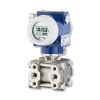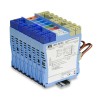Amplified Voltage Output is convenient and robust measurement signal over medium distances to use with analogue to digital converters.
The amplified voltage output is widely used in the automotive and aerospace industry in 3 wire (common negative connection) or 4 wire (isolated input and output) configurations, the former being the most widely used today.
A amplified voltage output uses less power than the more robust 4-20mA current output, but is less susceptible to noise and length losses than the mV/V output signal.
Featured amplified voltage output measurement products
 High Resolution Pressure Transducers - High resolution pressure transducers with an analog voltage output for detecting very small changes in pressure or measuring pressure to a high precision.
High Resolution Pressure Transducers - High resolution pressure transducers with an analog voltage output for detecting very small changes in pressure or measuring pressure to a high precision. 0-5 Volts Output Pressure Transducers - Industrial grade 0-5Vdc pressure transducers. These sensors provide a stable, amplified analog output ideal for automation, hydraulics, and process control.
0-5 Volts Output Pressure Transducers - Industrial grade 0-5Vdc pressure transducers. These sensors provide a stable, amplified analog output ideal for automation, hydraulics, and process control.
Glossary of Measurement Signal technical terms
- 2 Wire
- 3 Wire
- 4 to 20 mA Current Loop Output Signal
- 4 Wire
- BFSG – Bonded Foil Strain Gauge
- Deadband
- FSO – Full Scale Output
- HART®
- mV/V – Millivolts per Volt Output Signal
- NC – Normally Closed
- NO – Normally Open
- Piezoresistive Strain Gauges
- Ratiometric
- Span
- Span Offset
- Span Sensitivity
- Square Root Extraction
- Threshold
- Totalizer
- Transducer
- Transmitter
- TSL – Terminal Straight Line
- TSS – Thermal Span or Sensitivity Shift
- Turndown Ratio
- USB
- Vented Cable
- Wheatstone Bridge Strain Gauge
- Zero Offset
- Zero Tare
Help from Measurement Signal resources
- Why use 4-20mA and 3-15 psi rather than 0-20mA & 0-15psi
- Supply voltage and load resistance considerations for pressure transmitters
- What is the difference between zero offset and zero drift?




